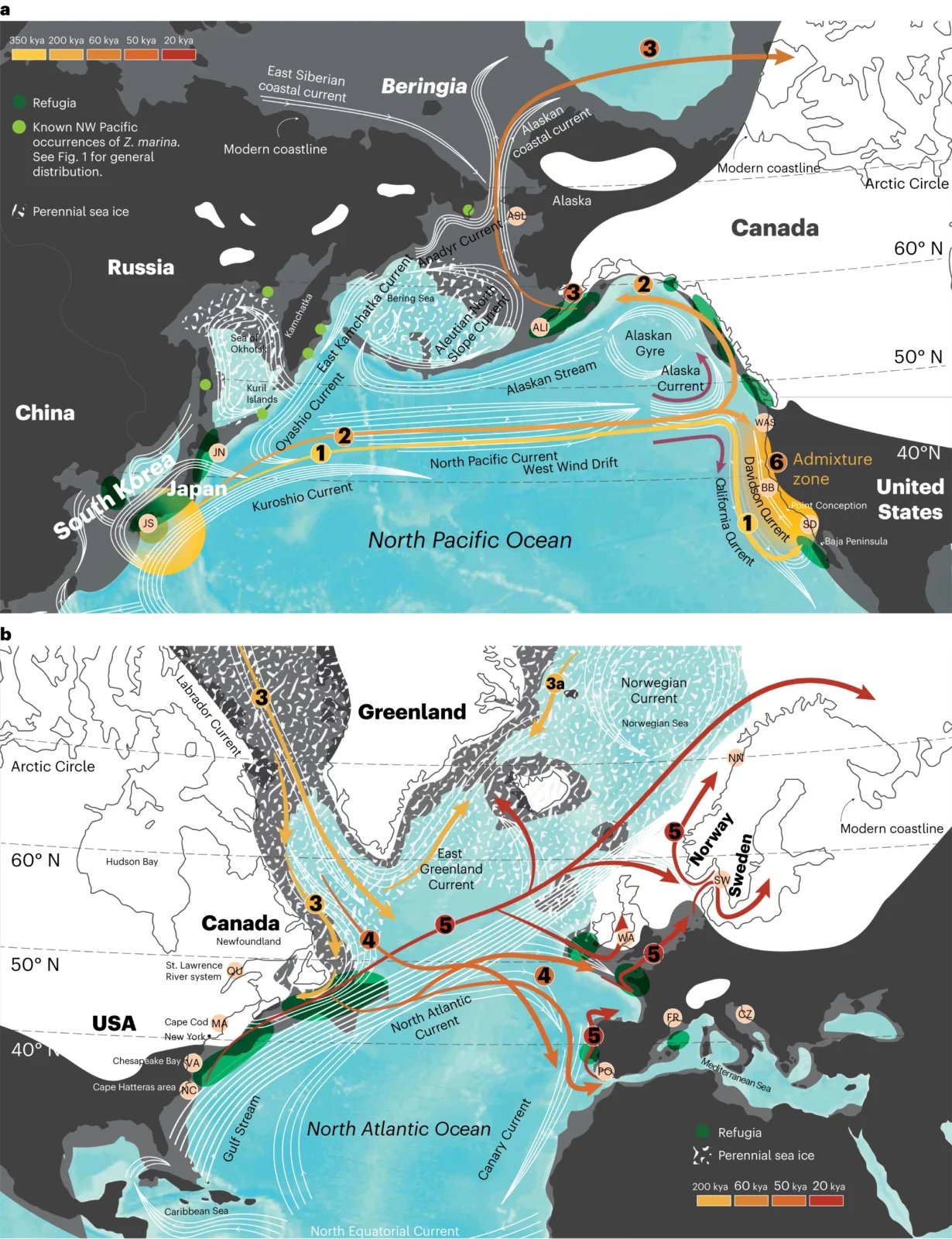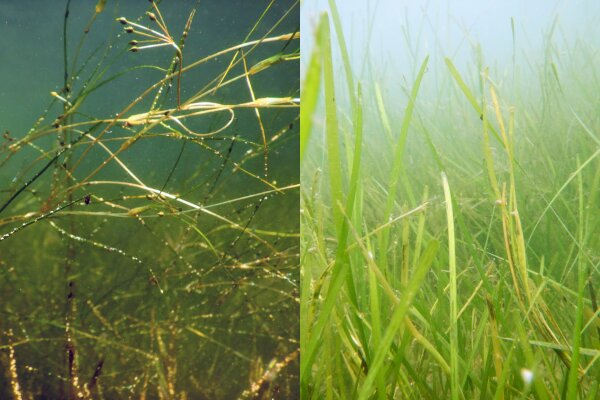How eelgrass spread around the world

Seagrasses evolved from freshwater plants and use sunlight and carbon dioxide (CO2) for photosynthesis and are able to thrive in depths down to 50 meters. In contrast to algae, they possess roots and rhizomes that grow in sandy to muddy sediments. The grass-like, leaf-shoots produce flowers and complete their life cycle entirely underwater. Seeds are negatively buoyant but seed-bearing shoots can raft, thus greatly enhancing dispersal distances at oceanic scale. As a foundational species, eelgrass (Zostera marina) provides critical shallow-water habitats for diverse biotas and also provides numerous ecosystem services including carbon uptake. Seagrasses have recently been recognized as one of the important nature-based contributions to store carbon in the ocean. The sediment below seagrass meadows can sequester between 30 and 50 times more carbon annually that the roots of forests on land. Unfortunately, the continuing loss of seagrass beds worldwide—including eelgrass—is of acute concern. An international group of researchers, including Richard Unsworth and coordinated by Professor Thorsten Reusch, Head of the Research Division Marine Ecology at GEOMAR Helmholtz Centre for Ocean Research Kiel, used complete nuclear and chloroplast genomes from 200 individuals and 16 locations to reconstruct and date the colonisation history of the eelgrass Zostera marina from its origin in the Northwest Pacific Ocean to the Pacific, Atlantic and the Mediterranean. The findings described in an article and a Research Briefing published in Nature Plants beg the question, “How well will eelgrass adapt to our new, rapidly changing climate?” Using a phylogenomic approach the scientists were able to determine that Z. marina first arose in the Japanese Archipelago region and then crossed the Pacific from west to east in at least two colonisation events, probably supported by the North Pacific Current. The scientists then applied two DNA “molecular clocks”—one based on the nuclear genome and one based on the chloroplast genome—to deduce the time when eelgrass populations diverged into new ones. The DNA mutation rate was calculated and calibrated against an ancient, whole genome duplication that occurred in eelgrass. Both nuclear and chloroplast genomes revealed that eelgrass dispersed to the Atlantic through the Canadian Arctic about 243 thousand years ago. This arrival is far more recent than expected—thousands of years versus millions of years, as is the case with most Atlantic immigrant species during the Great Arctic Exchange some 3.5 million years ago. Reusch explains, “We thus have to assume that there were no eelgrass-based ecosystems—hotspots of biodiversity and carbon storage—in the Atlantic before that time. Recency was also mirrored in an analysis of the associated faunal community, which features many fewer specialized animals in the Atlantic as compared to the Pacific eelgrass meadows. This suggests that there was less time for animal-plant co-evolution to occur.” Mediterranean populations were founded from the Atlantic about 44 thousand years ago and survived the Last Glacial Maximum. By contrast, today’s populations found along the western and eastern Atlantic shores only (re)expanded from refugia after the Last Glacial Maximum, about 19 thousand years ago—and mainly from the American east coast with help from the Gulf Stream. In addition, the researchers further confirmed the huge difference in genomic diversity between the Pacific and Atlantic, including latitudinal gradients of reduced genetic diversity in northern populations. “Both Atlantic compared to Pacific populations, and northern versus southern ones are less diverse on a genetic level than their ancestors by a factor of 35 among the most and least diverse one,” said postdoctoral scientist Dr. Lei Yu, first author of the publication, which was a chapter in his doctoral thesis. “This is due to bottlenecks arising from past ice ages, which raises concerns as to how well Atlantic eelgrass, will be able to adapt to climate change and other environmental stressors based on its genetic capacity.” “Warming oceans have already caused losses of seagrass meadows at the southern range limits, in particular North Carolina and southern Portugal. In addition, heat waves have also caused losses in shallow waters in some the northern parts of the distribution,” noted Reusch. “This is not good news because seagrass meadows form diverse and productive ecosystems, and no other species is able to take on the role of eelgrass if meadows cannot persist under future conditions.” “One possibility for restoration might be to borrow some genetic diversity from Pacific eelgrass to fortify diversity in the Atlantic. Our next step is to interrogate the eelgrass pangenome. A new reference genome from Pacific eelgrass is currently under development and should tell us more about the adaptive ecotypic capacity across its global range of habitats,” said Prof. Jeanine Olsen, emeritus professor from the University of Groningen who initiated the study and coordinated the work between the Joint Genome Institute (JGI) and the research team. More information: Yu, L. etal, Ocean current patterns drive the worldwide colonization of eelgrass (Zostera marina), Nature Plants (2023). DOI: 10.1038/s41477-023-01464-3 Story provided by Helmholtz Association of German Research Centres
Study reveals widgeongrass has replaced eelgrass as the dominant seagrass species in Chesapeake Bay

Mangroves are growing in areas historically dominated by salt marshes and oyster reefs. Invasive pacific oysters are replacing native blue mussels in the Wadden Sea. Macroalgae are exhibiting dominance over hard corals in the Caribbean and Indo-Pacific. Climate change-driven shifts in dominant, habitat-forming species such as these can have significant implications for conservation, and this is a phenomenon that seems to be particularly prevalent for seagrass systems around the world. In research published today in the Proceedings of the National Academy of Sciences, VIMS researchers and their collaborators evaluate the causes and consequences of a new dominant seagrass species rising in the Chesapeake Bay, demonstrating both new threats and management opportunities. For this study, the authors combined 38 years of data on nutrient and sediment pollution from runoff, temperature, plankton blooms, and river flow with aerial seagrass surveys to describe the causes and consequences of shifting seagrass foundation species across 26,000 hectares of habitat in Chesapeake Bay. Demonstrated shifts in seagrass create faster recovery but larger die-offs across Chesapeake Bay Marine heatwaves and poor water clarity in Chesapeake Bay over the last few decades have cut the area occupied by the previously dominant seagrass, eelgrass, in half. At the same time, successfully implemented nutrient reductions throughout the bay have encouraged the rapid expansion of another seagrass, the cosmopolitan widgeongrass. Confined to a fringing area of shallow brackish waters until the mid 1990s, widgeongrass has now replaced eelgrass as the most abundant seagrass in Chesapeake Bay by expanding over 150% due to both high temperature-tolerance and long-lasting seeds that allow for rapid recovery after disturbance. “Widgeongrass’ recovery and expansion ability is so strong,” explains lead author Hensel, “that ideal widgeongrass conditions have fueled two record-setting peaks for Chesapeake Bay seagrass cover. In fact, much of the nearly 300% increase in Bay plants since the mid 1990s has been widgeongrass expansion into areas that eelgrass has vacated.” However, some negative consequences from the shift have concerned habitat managers. “We’ve seen periods of rapid widgeongrass expansion and retraction for decades now, far beyond what we’ve documented for eelgrass,” says Landry, co-author and leader of the Chesapeake Bay Program’s Submerged Aquatic Vegetation (SAV) Workgroup. “But now that widgeongrass has become so widespread in the bay, its fluctuating abundance can have a big impact on our overall acreage trends and on our Bay-wide restoration goal attainment. That’s the management concern. The ecological concern is the impact those fluctuations are having on the animals that have grown to depend on widgeongrass for habitat in the absence of eelgrass.” The causes of these fluctuations have been difficult to understand because widgeongrass and eelgrass appear to respond differently to climate change and nutrient pollution stressors. Yet when the authors examined long-term, large-scale data on climate stressors and watershed pollution from agriculture and development in tandem with year-to-year aerial survey imagery of seagrass meadows, they recognized an important shift in the dominant climate stressor for Chesapeake Bay seagrass: while widgeongrass is resistant to heatwaves and high temperatures, it is highly vulnerable to periods in spring when high rains can bring huge influxes of nutrient- and sediment-loaded water into the bay, reducing water clarity. “This study is an important step forward in building our knowledge of human-ecosystem interactions along the coast and how they are changing over time,” says author Lefcheck. “Our past work showed a record-setting resurgence of underwater grasses in response to nutrient management, but now we are seeing that the story is vastly more complex and in fact, is still being written. Understanding, adapting to, and communicating this shifting narrative is a challenge, but not an insurmountable one by any stretch.” Conserving species with different needs simultaneously is necessary, complex The team’s modeling contributes to a greater understanding of both human and climate drivers of annual changes in widgeongrass and highlights a crucial difference in management compared to an eelgrass-dominated bay. “Heatwave stress is uncontrollable on a local and regional level,” explains Patrick, Director of the SAV Monitoring Program at VIMS, “but managing the amount of nutrients that enter the bay from the watershed during a rainy spring is something that we can actually control.” This study underscores that, because species differ in their traits and stressor sensitivities, managing for conservation of living habitats requires more community- or species-focused research, monitoring, and actions under climate change. Climate change is shifting the landscape of species composition, creating new winners in these novel environments, and management needs to shift alongside them. Detailed monitoring data allow agencies to focus on each species and encourages them to manage for community or individual habitat requirements, adapting strategies as species composition changes. This study also demonstrates pitfalls that can occur if habitat forming species are lumped together into single “stocks,” such as “hectares of seagrass” or “acres of marsh.” In fact, differences between the seagrass species in this study explain many of the shifts in Chesapeake Bay seagrass meadow dynamics. “Widgeongrass has shorter, thinner blades than eelgrass,” says Hensel, “which makes it more vulnerable to springtime run-off events because sunlight can’t reach the short blades through the clouded, nutrient-loaded water. Also, widgeongrass’ shallower root system may not sequester carbon as well and its tendency to wildly fluctuate in cover means that it may not provide consistent habitat for key seagrass-dependent species like Blue Crabs and Black Sea Bass.” The authors call for a parallel shift in coastal monitoring and evaluation of management successes and failures, using the Chesapeake Bay as an example. They cite the necessity of long-term monitoring programs with coordinated and standardized on-the-ground and detail-oriented surveys, as well as the importance of community or species-specific recovery goals across coastlines where multiple seagrass species co-occur and respond to climate differently. “This is a compelling example of the how climate change is unfolding across the globe,” said Patrick. “As regional climates shift, the emergence of novel ecosystems is fundamentally challenging everything we think we know from analysis of historical data. The rules governing the dynamics of the world’s ecosystems are changing and

